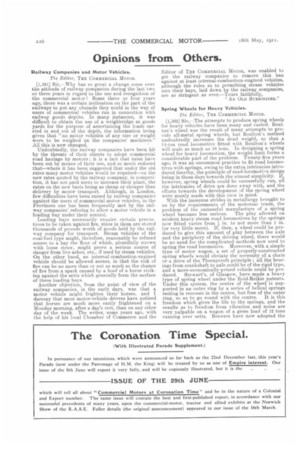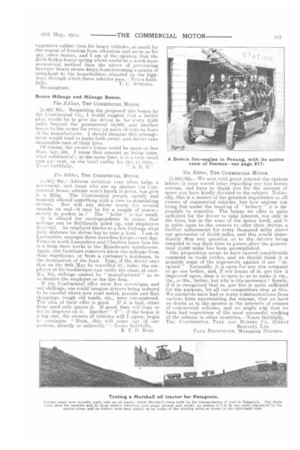Opinions from Others.
Page 20

Page 23

If you've noticed an error in this article please click here to report it so we can fix it.
Pailway Companies and Motor Vehicles.
The Editor, THE COMMERCIAL MOTOR.
[I,361) Sir,—Why has so great a change come over the attitude of railway companies during the last two or three years in regard to the use and recognition of the commercial motar 1 Some three or four years ago, there was a certain inclination on the part of the railways to put any obstacle they could in the way of users of commercial vehicles run in connection with railway goods depots. In many instances, it was difficult to obtain the use of a weighbridge at goods yards for the purpose of ascertklinmg the loads carried in and out of the depot, the information being given that "no motor vehicles of any size or weight were to be weighed on the companies' machines." All this is now changed.
Undoubtedly, the railway companies have been hit by the threats of their clients to adopt commercial road haulage by motors ; it is a fact that rates have been cut by means of their use, and so much reduced that—where it has been suggested that under the old rates many motor vehicles would be required—on the new rates quoted by the railway company, in competition, it has not paid users to increase their plant, the rates on the new basis being as cheap or cheaper than delivery by motor transport. Although, in London, few difficulties have been raised by railway companies against the users of commercial motor vehicles, in the Provinces one has been frequently met by the railway companies' refusing to allow a motor vehicle in a loading bay under their control.
Loading bays necessarily require certain precautions to be taken against fire, since in them are stored thousands of pounds worth of goods held by the railway company for transport. Steam vehicles of the coal-fuel type might, therefore, reasonably be refused access to a bay the floor of which, plentifully strewn with loose straw, might prove a serious source of danger from live ashes, etc., if used by steam vehicles. On the other hand, an internal-combustion-engined vehicle should be allowed access, in that the risk of fire can be no more than or not as much as the chance of fire from a spark caused by a hoof of a horse striking against the setts which generally form the surface of these loading bays. Another objection, from the point of view of the railway companies, in the early days, was that a motor vehicle might frighten their horses, and I daresay that most motor-vehicle drivers have noticed that horses are much more easily frightened on a Monday morning, after a day's rest, than on any other day of the week. The writer, some years ago, with the help of his local Chamber of Commerce and the Editor of Tax COMMERCIAL Moron, was enabled to get the railway companies to remove this ban against at least internal-combustion-engined vehicles, although the rules as to permitting steam vehicles into their bays, laid down by the railway companies, are as stringent as ever.—Yours faithfully, " AN OLD SUBSCRIBER."
Spring Wheels for Heavy Vehicles.
The Editor, THE COMMERCIAL MOTOR.
[1,362] Sir,—The attempts to produce spring wheels for heavy vehicles have been many and varied. Boutton's wheel was the result of many attempts to provide all-metal spring wheels, but BouIton's method undoubtedly increases the dead weight, so that a 14-ton road locomotive fitted with Boulton's wheels will scale as much as 16 tons. In designing a spring wheel for heavy locomotion, the weight limit forms a considerable part of the problem. Twenty-five years ago, it was an uncommon practice to fit road locomotives with springs, owing to the extra intricacies introduced thereby, the principle of road-locomotive design being in those days towards the utmost simplicity, lf, however, spring wheels could be successfully run, all the intricacies of drive are done away with and the efforts towards the development of the spring wheel were mostly made with this view in mind.
With the immense strides in metallurgy brought to us by the requirements of the motorcar trade, the problem of the successful manufacture of a spring wheel becomes less serious. The play allowed on modern heavy steam road locomotives by the springs now fitted varies from in. to not more than 1 in. (or very little more). If, then, a wheel could be produced to give this amount of play between the axle and the periphery of the driving wheel, there would be no need for the complicated methods now used to spring the road locomotive. Moreover, with a simple type of motor wagon, a set of properly-constructed spring wheels would obviate the necessity of a chain or a drive of the Thornycroft principle ; all the bearings from crankshaft to axle could be of the rigid type, and a more-economically-priced vehicle could be produced. Stewart's, of Glasgow, have made a heavy type of spring wheel under the Reid-Reikie patents. Under this system, the centre of the wheel is supported in an outer ring by a series of helical springs resting in recesses in the centre, but. free of the outer ring, so as to go round with the centre. It is this freedom which gives the life to the springs, and the results as to freedom from vibration and noise are very palpable on a wagon of a. gross load of 12 tons running over setts. Brewers have now adopted the expensive rubber tires for heavy vehicles, as much for the reason of freedom from vibration and noise as for any other reason, and I am of the opinion that the Reid-.1-teikie heavy spring wheel would be a much rianre economical method than the above of preventing brewers' heavy steam drays from becoming a source of complaint to the householders situated on the highways through which these vehicles pass.--Yours faith
fully. T. C. AVELING. Bi mingharn_ Bonus Mileage and Mileage Bonus.
The Editor, THE COMMERCIAL MOTOR.
(1,363] Sir,—Respecting the proposed tire bonus by the Continental Co., I would suggest that a better plan would be to give the driver 5s. for every 2,500 miles beyond the guaranteed 10,000, and another bonus to the owner for every six pairs of tires he buys of the manufacturer. I should imagine this arrangement would tend to make both owner and driver take reasonable care of their tires.
Of course, the owner's bonus could be more or less than, say, 50s. I name that amount as being somewhat substantial ; at the same time, it. is a very small sum per cent. on the total outlay for the 12 tires.—
Yen rs faithfully, " A. R. B.
The Editor, THE COMMERCIAL MOTOR.
i,360 Sir,– Adverse criticism very often helps a movement, and those who are up against the Continental bonus scheme won't knock it down, but. give it a fillip. The Continental people openly and honestly offered something with a view to stimulating drivers, But will any driver worry for seve.rad months on end—it may be for a couple of years— moiety to pocket 5s. ? The "bribe " is too small.
It is absurd for correspondents to argue that mileage can be fictitiously piled up, and employers draa ived. An employer knows to a few furlongs what daily distance his driver has to take a load. I am in Lancashire, amongst these horseless lorries every day. Firms in north Lancashire and Cheshire know how far it is from their works to the Manchester warehouses. Again, city furniture removers know the mileage from their warehouse, or from a customer's residence, to the destination of the load. Ergo, if the. driver says that on the 20th May he travelled 51..1, miles, the employer or his bookkeeper can verify the claim at once. _No, Sir, mileage cannot be " manufactured " so as to deceive the employer or the tire firm.
If the Continental offer were five sovereigns and not shillings, one could imagine drivers being Induced to be careful where new road metal, granite and flint chippings, rough old roads, etc., were encountered. The idea of their offer is good. If it is bad, other firms need only ignore it. If good, they will copy or try to improve on it. Another " if "—if the bonus is a big one, the owners of vehicles will I agree, begin to ruminate, " Hum, this will come out of our pockets, directly or indirectly."—Yours faithfully,
R E. D ROSE.
The Editor, THE COMMERCIAL MOTOR.
[1,365] Sir,—We note with great interest the various letters in your recent issue regarding our tire bonus scheme, and have to thank you for the amount of space you have kindly devoted to the subject. Naturally, this is a matter of the greatest importance to all owners of commercial vehicles, but how anyone can brini5 this under the heading of " bribery " it is impossible to conceive. The bonus we offer is quite sufficient for the driver to take interest, not only in the tires, but in the wear of the motor itself, and it is quite open to the owners to offer their drivers a further inducement for every thousand miles above our guarantee of 10,000 miles, and this would immediately gtop any question as to the drivers being tempted to run their tires to pieces after the guaranteed 10,000 miles has been accomplished. Our proposition seems to have caused considerable comment in trade circles, and we should think it is possible some of the arguments against it are " inspired." Naturally, it is open for any tire company to go one better, and, if our bonus of Si. per tire is improved upon, then it is open to us to make it tOs., 15s., or 20s., better, but why is this necessary ? Surely, if it is recognized that 5s. per tire is quite sufficient for the purpose, let all our competitors stop at this. We ourselves have had so many communications from various firms appreciating the scheme, that we have no doubt as to the success in the interests of owners of commercial vehicles, and we might wie that we have had experience of the most successful working of the scheme in other countries.--Yours faithfully,
THE CONTINENTAL TYRE AND RUBBER CO. (GREAT BRITAIN), LTD.
PAUL BRODTATANN, Managing Director.


























